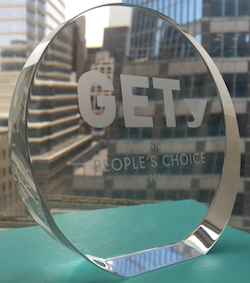 An “open-source” approach to accelerating human health advances is the common theme among a diverse group of medical science projects that have won six science awards honoring “excellence in participant-centered research” - a rapidly emerging field that aims to turn patients and healthy people into more active and more data-sharing participants in medical research. The awards will be given out at Harvard Medical School in Boston on April 25 at a scientific convening called GET Conference (“GET” stands for “Genomes, Environments, Traits”). “The winners of the GETy Awards are at the forefront of a research revolution that will radically accelerate the rate of human health advances,” says Jason Bobe, organizer of the GET Conference, and Executive Director of the nonprofit PersonalGenomes.org.
An “open-source” approach to accelerating human health advances is the common theme among a diverse group of medical science projects that have won six science awards honoring “excellence in participant-centered research” - a rapidly emerging field that aims to turn patients and healthy people into more active and more data-sharing participants in medical research. The awards will be given out at Harvard Medical School in Boston on April 25 at a scientific convening called GET Conference (“GET” stands for “Genomes, Environments, Traits”). “The winners of the GETy Awards are at the forefront of a research revolution that will radically accelerate the rate of human health advances,” says Jason Bobe, organizer of the GET Conference, and Executive Director of the nonprofit PersonalGenomes.org.
University of Colorado Boulder
See the following -
10 of Today's Really Cool Network & IT Research Projects
University at Buffalo and Northeastern University researchers are developing hardware and software to enable underwater telecommunications to catch up with over-the-air networks. This advancement could be a boon for search-and-rescue operations, tsunami detection, environmental monitoring and more. Sound waves used underwater are just no match for the radio waves used in over-the-air communications, but the researchers are putting smart software-defined radio technology to work in combination with underwater acoustic modems...
- Login to post comments
2017 Massry Prize Honors Microbiome Research Pioneers

Microbiome researchers Rob Knight, PhD, University of California San Diego, Jeffrey Gordon, MD, Washington University School of Medicine in St. Louis, and Norman Pace, PhD, University of Colorado Boulder, will share this year’s Massry Prize, splitting the $200,000 honorarium. These researchers lead a field that works to produce a detailed understanding of microbiomes — distinct constellations of bacteria, viruses and other microorganisms that live within and around us — and methods for manipulating microbiomes for the benefit of human and environmental health.
- Login to post comments
California Could Be Hit by an 8.2 Mega-Earthquake, and It Would Be Catastrophic
 The magnitude 8.2 earthquake that ravaged southern Mexico on Sept. 7 was the largest to shake the country in nearly a century. Like California, Mexico is a seismically active region that has seen smaller quakes that have caused death and destruction. But the Sept. 7 temblor is a reminder that even larger quakes — while rare — do occur. Scientists say it’s possible for Southern California to be hit by a magnitude 8.2 earthquake. Such a quake would be far more destructive to the Los Angeles area because the San Andreas fault runs very close to and underneath densely populated areas...
The magnitude 8.2 earthquake that ravaged southern Mexico on Sept. 7 was the largest to shake the country in nearly a century. Like California, Mexico is a seismically active region that has seen smaller quakes that have caused death and destruction. But the Sept. 7 temblor is a reminder that even larger quakes — while rare — do occur. Scientists say it’s possible for Southern California to be hit by a magnitude 8.2 earthquake. Such a quake would be far more destructive to the Los Angeles area because the San Andreas fault runs very close to and underneath densely populated areas...
- Login to post comments
GETy Awards Celebrate Unorthodox Open-Source Approaches to Accelerating Human Health Advances
- Login to post comments
New Light-Activated Nanoparticles Kill Over 90% of Antibiotic-Resistant Bacteria
Bacterial resistance to antibiotics is a growing problem around the world, responsible for some 2 million infections in the US each year that lead to approximately 23,000 deaths. But a new nanoparticle treatment developed by researchers at the University of Colorado Boulder could provide an effective means of fighting antibiotic-resistant bacteria including Salmonella, E. Coli, and Staphylococcus, based on results in a laboratory environment. In testing with a lab-grown culture, the nanoparticles killed 92 percent of drug-resistant bacterial cells while leaving the other cells intact...
- Login to post comments